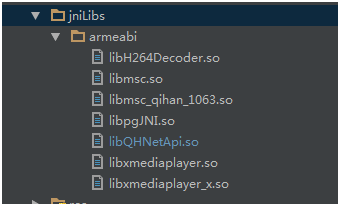QLinkDemo Android接口文档
1.搭建开发环境(Android Studio环境)
a) 在Android Studio 建立你的工程
b) 把demo工程libs目录的jar包复制到你的工程,并引入以下Jar库,classes.jar是封装库,源码在mylibrary工程中,msc和pgnpp是视频库,mpermissions 是第3方动态权限申请库。

c) 在项目src/main 目录下建立jniLibs文件夹,把demo 工程中的*.so后缀文件复制到jniLibs文件夹下。

d) 权限配置,在AndroidManifest.xml 添加以下权限。

2.开始使用
a) 初始化网络库,非阻塞,程序启动时调用
public native int initLib(int app_id, String domain, int port, String version);
app_id 保存在清单文件中,用来区分不同的版本渠道
domain 服务器IP
Port 服务器端口
Version 当前版本
Returen 非0即错误码(错误码查询在NetInfo文件中)
b) 反初始化网络库,阻塞型,程序结束时调用。
Returen 非0即错误码
public native int cleanupLib();
3.如何登录
public native int onLogin(LoginAccount loginAccount);
参数说明:
LoginAccount class
accountType:帐号类型qlink_id/tel/mail
account:帐号
password:密码
回调参数:NetInfo.QHC_CMD_LOGIN_RSP
返回参数:
返回0 成功 其他为错误码
4.如何处理回调

在NetApi中,有2个回调方法,showRecv处理常用的方法回调,showVideo处理视频回调。
void showRecv(int cmd, int result, Object obj, long seq);
cmd: 回调的命令字
result: 错误码 0-成功 其他-错误
obj: 由JNI层请求网络返回的数据
seq:请求码,与每个请求的seq值对应
void showVideo(int handle, byte[] data, int len, width, int height, int sec, int type);
handle:打开视频时的会话
data:音频数据(PCM数据)或者视频数据(RGB565图片数据)
len:数据长度
width:视频宽度
height:视频高度
type:数据类型 1 I帧 2 P帧 3音频
相互保密协议
甲方:深圳市三宝创新云技术有限公司
乙方:开发者
鉴于:
甲乙双方正在进行会谈或合作,需要获悉对方的相关业务和技术资料,为此,甲乙双方本着互惠互利、共同发展的原则,经友好协商签订本协议。
1. 保密资料的定义
甲乙双方中任何一方披露给对方的明确标注或指明是“保密资料”的相关业务和技术方面的
书面或其它形式的资料和信息(简称:保密资料),但不包括下述资料和信息:
(1) 已经或将公布于众的资料,但不包括甲乙双方或其代表违反本协议规定未经授权所披露的;
(2) 在任何一方向接受方披露前已为该方知悉的非保密性资料;
(3) 任何一方提供的非保密资料,接受方在披露这些资料前不知此资料提供者(第三方)已经与本协议下的非保密资料提供方订立过有约束力的保密协议,且接受方有理由认为资料披露者未被禁止向接受方提供该资料。
2. 双方责任
(1) 甲乙双方互为保密资料的提供方和接受方,负有保密义务,承担保密责任。
(2) 甲乙双方中任何一方未经对方书面同意不得向第三方(包括新闻界人士)公开和披露任何保密资料或以其他方式使用保密资料。双方也须促使各自代表不向第三方(包括新闻界人士)公开或披露任何保密资料或以其它方式使用保密资料。除非披露、公开或利用保密资料是双方从事或开展合作项目工作在通常情况下应承担的义务(包括双方今后依法律或合同应承担的义务)适当所需的。
(3) 双方均须把保密资料的接触范围严格限制在因本协议规定目的而需接触保密资料的各自负责任的代表的范围内。
(4) 除经过双方书面同意而必要进行披露外,任何一方不得将含有对方或其代表披露的保密资料复印或复制或者有意无意地提供给他人。
(5) 如果合作项目不再继续进行或其中一方因故退出此项目,经对方在任何时候提出书面要求,另一方应当、并应促使其代表在五个工作日内销毁或向对方返还其占有的或控制的全部保密资料以及包含或体现了保密资料的全部文件和其它材料并连同全部副本。但是在不违反本协议其它条款的条件下,双方可仅为本协议第四条之目的,保留上述文件或材料的复制件一份。
(6) 甲乙双方将以并应促使各自的代表以不低于其对自己拥有的类似资料的照料程度来对待对方向其披露的保密资料,但在任何情况下,对保密资料的照料都不能低于合理程度。
(7) 乙方不得以任何方式反编译、脱壳甲方提供的jar包、so文件、以及相关目标文件。
(8) 乙方不得将甲方所提供的任何控制指令以及中间件提供给任何第三方。
(9) 乙方不得在代码中将qh相关字符删除或者修改之后,输出给第三方。
(10) 乙方不得将甲方的代码、机器人控制思路、策略提供给任何第三方或发布到开源社区。
(11) 乙方不得将甲方提供的虚拟机镜像文件提供给任何第三方。
3. 知识产权
甲乙双方向对方或对方代表披露保密资料并不构成向对方或对方的代表的转让或授予另一方对其商业秘密、商标、专利、技术秘密或任何其它知识产权拥有的权益,也不构成向对方或对方代表转让或向对方或对方代表授予该方受第三方许可使用的商业秘密、商标、专利、技术秘密或任何其他知识产权的有关权益。
4. 保密资料的保存和使用
(1) 甲乙双方中的任何一方有权保存必要的保密资料,以便在履行其在合作项目工作中所承担的法律、规章与义务时使用该等保密资料。
(2) 甲乙双方有权使用保密资料对任何针对接受方或其代表的与本协议项目及其事务相关的索赔、诉讼、司法程序及指控进行抗辩,或者对与本协议项目及其事务相关的传唤、传票或其他法律程序做出答复。
(3) 任何一方在书面通知对方并将披露的复印件抄送对方后,可根据需要在提交任何市、省、中央或其他对接受方有管辖权或声称对接受方有管辖权的监管团体的任何报告、声明或证明中披露保密资料。
5. 争议解决和适用法律
本协议受中华人民共和国法律管辖并按中华人民共和国法律解释。对因本协议或本协议各方的权利和义务而发生的或与之有关的任何事项和争议、诉讼或程序,本协议双方不可撤销地接受中华人民共和国甲方所在地人民法院的管辖。